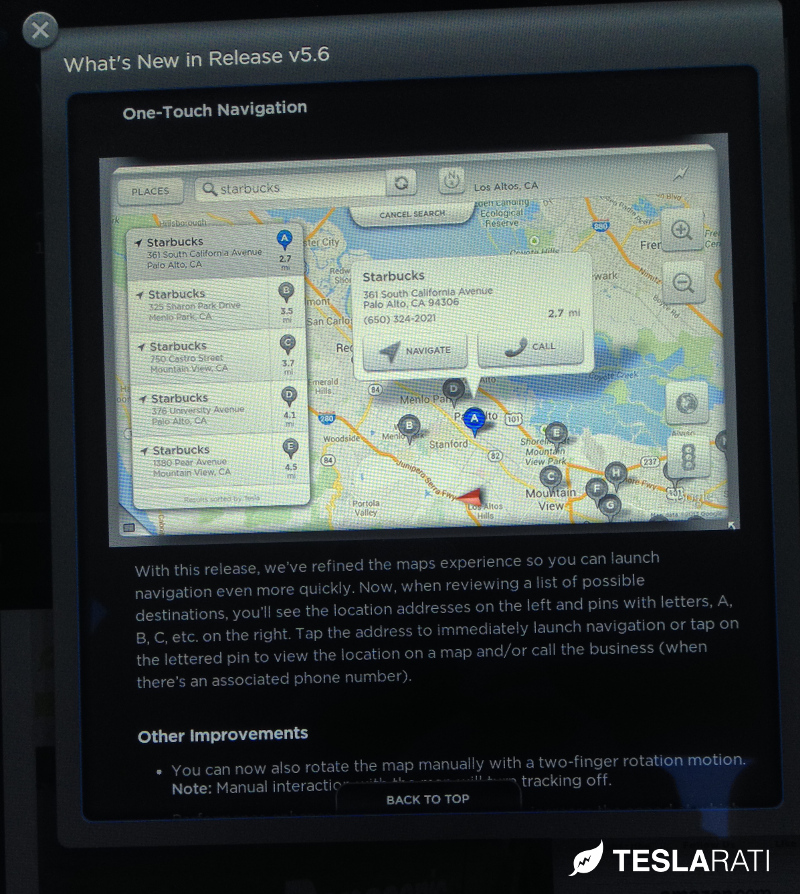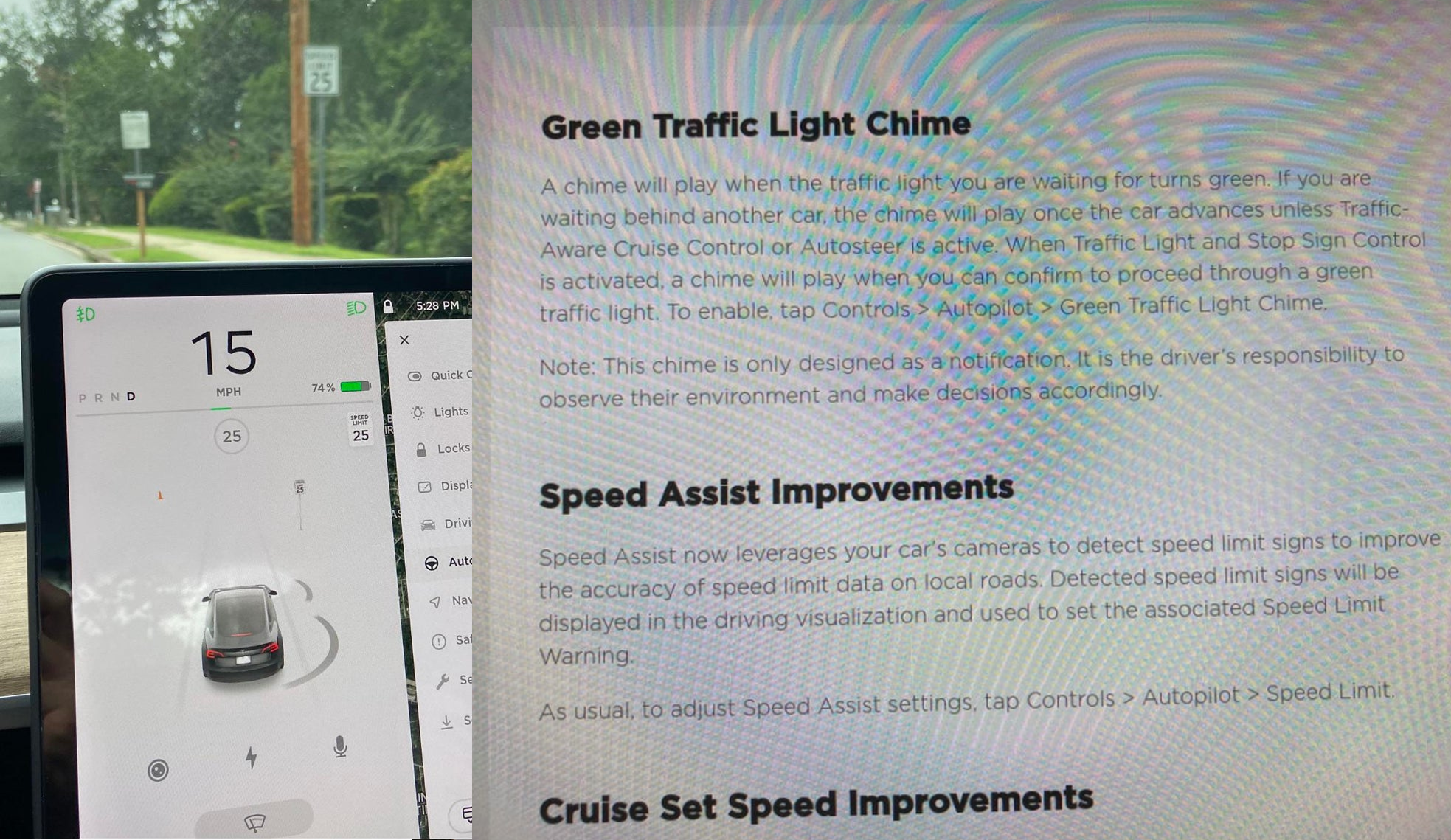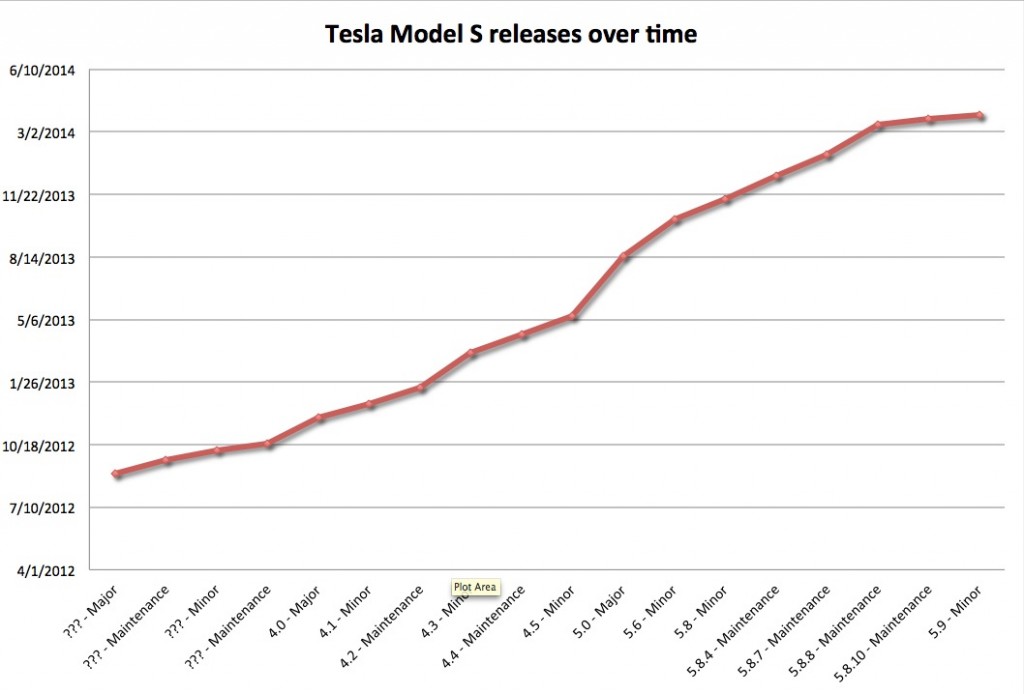Firmware
Everything you need to know about Tesla software updates

One of the greatest joys of owning a Tesla is being able to experience new features and functionality that get rolled out through over-the-air (OTA) software updates. But when do these updates happen and at what frequency is it released? I set out to study Tesla’s release cycle in hopes to find an answer.
Locating the Version Number
First, the basics. You can locate your current version and build information by touching the Tesla logo at the top center of your 17″ display. You’ll see a nice picture of your car, your VIN and then the release notes for your software.
![]()
Clicking on the “Release Notes” link will bring up the list of features and enhancements that have been packaged into that particular release. Releases have a version number and a build number. The first set of numbers denotes the version and in this case it’s Version 5.9. The second set of numbers within parentheses are the build numbers, in this case 1.51.94. More on these two numbers below.
Version Numbers
Version numbers are comprised of three sets of digits separated by a decimal.
<Major Version> . <Minor Version> . <Maintenance Version>
If the major version number changes, it’s considered a major release which will likely contain new features, however Tesla has been known to also add new functionality in their minor releases (changes to the minor version number). Version 5.9 and 5.6 are great examples of releases that contained substantial feature upgrades.
Maintenance releases on the other hand do not contain new features but address bugs and issues that were introduced in the previous major or minor release.
Build Numbers
A release can have many builds associated with it and it’s not always clear what changes between these builds since it’s not captured within the release notes. For example the 5.9 minor release started with build 1.51.88 and is currently at build 1.51.96. It also appears that the build you get with your release is the one you stay on until the next release. For example, my Model S came with 5.9 build 1.51.94 but the latest build is at 1.51.96. So, in theory there are fixes between 1.51.94 and 1.51.96 that I don’t have and won’t be able to get.
Build numbers are usually incremented each time the software is compiled, which includes the branch of software. Tesla software build numbers most likely conform to the following standards:
<product number> . <software branch> . <build number>
The product number would be “1” for Tesla Model S. Each release target has its own release branch (i.e. branch “51” for the 5.9 release), then an incrementing build number within that branch. Those builds would be on a release branch with changes merged in from an active development branch. So one “tick” or increment in the build number that we see in the visible build number could be many code changes/builds within their development/QA process. This is all a guess since Tesla has made no public statements on this, but what I’ve outlined is common practice in software development.
Release History
I found a total of 18 Tesla software updates since the introduction of the Model S in September of 2012. Plotting these release dates over time paints a good picture of their release cycle.
If we take a look at only the version changes, we can see that Tesla on average releases new software updates every 34 days.
Should we be concerned about the reduced rate of change in 2014? Is Telsa slowing down development? Probably not. 2014 is still young and we know Tesla is working on major updates for its 6.0 release. It is very common for minor and maintenance releases to slow down in the final preparation stages of a major release and both the 4.0 and 5.0 releases showed this pre-release slowdown.
Tesla on average releases new software updates every 34 days.
I actually think its positive news that releases are slowing as this indicates 6.0 may be close! What will be in it is still up for much discussion, but no doubt it will be a good one.
Major Releases
Tesla appears to do a major release once a year:
- V4.0: November 2012
- V5.0: August 2013
- V6.0: Expected 2014.
Their versioning scheme seemed to have changed between 2013 to 2014. Prior to 2014 there were no releases with maintenance versions (i.e. only 2 digits) but from the contents several of those releases were maintenance releases. That makes analysis of the minor releases a bit more difficult as prior to 2014 they were all considered major or minor and not maintenance. I used the release contents to classify releases between minor and maintenance for the above chart — if they only included fixes (no new functionality) then I considered them maintenance releases.
Tesla seems to be going at a rate of a minor release every quarter:
- 2014: March (still early in 2014)
- 2013: March, May, October, November
- 2012: October, December (started in September)
The above is a big guess with small numbers, but it is a very common strategy to do a major release once a year with minor releases more frequent throughout the year. If you look at the averages:
Minor releases occur on average every 60 days.
Maintenance releases as you’d expect occur much more frequently. For example there were a bunch of maintenance releases this winter to address Model S’ in cold climates. Other hot topics like vampire drain and UMC fire risk also drove maintenance releases.
Summary
Tesla has changed the entire paradigm of how software is used within cars with their OTA software updates. By analyzing these software updates over time, we might be able to predict when the next Tesla software update will arrive and, better yet, what caliber of update it will be.
The Model S is an amazing car that only gets better with time.

Firmware
Tesla mobile app shows signs of upcoming FSD subscriptions

It appears that Tesla may be preparing to roll out some subscription-based services soon. Based on the observations of a Wales-based Model 3 owner who performed some reverse-engineering on the Tesla mobile app, it seems that the electric car maker has added a new “Subscribe” option beside the “Buy” option within the “Upgrades” tab, at least behind the scenes.
A screenshot of the new option was posted in the r/TeslaMotors subreddit, and while the Tesla owner in question, u/Callump01, admitted that the screenshot looks like something that could be easily fabricated, he did submit proof of his reverse-engineering to the community’s moderators. The moderators of the r/TeslaMotors subreddit confirmed the legitimacy of the Model 3 owner’s work, further suggesting that subscription options may indeed be coming to Tesla owners soon.
Did some reverse engineering on the app and Tesla looks to be preparing for subscriptions? from r/teslamotors
Tesla’s Full Self-Driving suite has been heavily speculated to be offered as a subscription option, similar to the company’s Premium Connectivity feature. And back in April, noted Tesla hacker @greentheonly stated that the company’s vehicles already had the source codes for a pay-as-you-go subscription model. The Tesla hacker suggested then that Tesla would likely release such a feature by the end of the year — something that Elon Musk also suggested in the first-quarter earnings call. “I think we will offer Full Self-Driving as a subscription service, but it will be probably towards the end of this year,” Musk stated.
While the signs for an upcoming FSD subscription option seem to be getting more and more prominent as the year approaches its final quarter, the details for such a feature are still quite slim. Pricing for FSD subscriptions, for example, have not been teased by Elon Musk yet, though he has stated on Twitter that purchasing the suite upfront would be more worth it in the long term. References to the feature in the vehicles’ source code, and now in the Tesla mobile app, also listed no references to pricing.
The idea of FSD subscriptions could prove quite popular among electric car owners, especially since it would allow budget-conscious customers to make the most out of the company’s driver-assist and self-driving systems without committing to the features’ full price. The current price of the Full Self-Driving suite is no joke, after all, being listed at $8,000 on top of a vehicle’s cost. By offering subscriptions to features like Navigate on Autopilot with automatic lane changes, owners could gain access to advanced functions only as they are needed.
Elon Musk, for his part, has explained that ultimately, he still believes that purchasing the Full Self-Driving suite outright provides the most value to customers, as it is an investment that would pay off in the future. “I should say, it will still make sense to buy FSD as an option as in our view, buying FSD is an investment in the future. And we are confident that it is an investment that will pay off to the consumer – to the benefit of the consumer.” Musk said.
Firmware
Tesla rolls out speed limit sign recognition and green traffic light alert in new update

Tesla has started rolling out update 2020.36 this weekend, introducing a couple of notable new features for its vehicles. While there are only a few handful of vehicles that have reportedly received the update so far, 2020.36 makes it evident that the electric car maker has made some strides in its efforts to refine its driver-assist systems for inner-city driving.
Tesla is currently hard at work developing key features for its Full Self-Driving suite, which should allow vehicles to navigate through inner-city streets without driver input. Tesla’s FSD suite is still a work in progress, though the company has released the initial iterations of key features such Traffic Light and Stop Sign Control, which was introduced last April. Similar to the first release of Navigate on Autopilot, however, the capabilities of Traffic Light and Stop Sign Control were pretty basic during their initial rollout.
2020.36 Showing Speed Limit Signs in Visualization from r/teslamotors
With the release of update 2020.36, Tesla has rolled out some improvements that should allow its vehicles to handle traffic lights better. What’s more, the update also includes a particularly useful feature that enables better recognition of speed limit signs, which should make Autopilot’s speed adjustments better during use. Following are the Release Notes for these two new features.
Green Traffic Light Chime
“A chime will play when the traffic light you are waiting for turns green. If you are waiting behind another car, the chime will play once the car advances unless Traffic-Aware Cruise Control or Autosteer is active. When Traffic Light and Stop Sign Control is activated, a chime will play when you can confirm to proceed through a green traffic light. To enable, tap Controls > Autopilot > Green Traffic Light Chime.
“Note: This chime is only designed as a notification. It is the driver’s responsibility to observe their environment and make decisions accordingly.”
Speed Assist Improvements
“Speed Assist now leverages your car’s cameras to detect speed limit signs to improve the accuracy of speed limit data on local roads. Detected speed limit signs will be displayed in the driving visualization and used to set the associated Speed Limit Warning.
“As usual, to adjust Speed Assist settings, tap Controls > Autopilot > Speed Limit.”
Footage of the new green light chime in action via @NASA8500 on Twitter ✈️ from r/teslamotors
Amidst the rollout of 2020.36’s new features, speculations were abounding among Tesla community members that this update may include the first pieces of the company’s highly-anticipated Autopilot rewrite. Inasmuch as the idea is exciting, however, Tesla CEO Elon Musk has stated that this was not the case. While responding to a Tesla owner who asked if the Autopilot rewrite is in “shadow mode” in 2020.36, Musk responded “Not yet.”
Firmware
Tesla rolls out Sirius XM free three-month subscription

Tesla has rolled out a free three-month trial subscription to Sirius XM, in what appears to be the company’s latest push into making its vehicles’ entertainment systems more feature-rich. The new Sirius XM offer will likely be appreciated by owners of the company’s vehicles, especially considering that the service is among the most popular satellite radios in the country today.
Tesla announced its new offer in an email sent on Monday. An image that accompanied the communication also teased Tesla’s updated and optimized Sirius XM UI for its vehicles. Following is the email’s text.
“Beginning now, enjoy a free, All Access three-month trial subscription to Sirius XM, plus a completely new look and improved functionality. Our latest over-the-air software update includes significant improvements to overall Sirius XM navigation, organization, and search features, including access to more than 150 satellite channels.
“To access simply tap the Sirius XM app from the ‘Music’ section of your in-car center touchscreen—or enjoy your subscription online, on your phone, or at home on connected devices. If you can’t hear SiriusXM channels in your car, select the Sirius XM ‘Subscription’ tab for instruction on how to refresh your audio.”
Tesla has actually been working on Sirius XM improvements for some time now. Back in June, for example, Tesla rolled out its 2020.24.6.4 update, and it included some optimizations to its Model S and Model X’s Sirius XM interface. As noted by noted Tesla owner and hacker @greentheonly, the source code of this update revealed that the Sirius XM optimizations were also intended to be released to other areas such as Canada.
Interestingly enough, Sirius XM is a popular feature that has been exclusive to the Model S and X. Tesla’s most popular vehicle to date, the Model 3, is yet to receive the feature. One could only hope that Sirius XM integration to the Model 3 may eventually be included in the future. Such an update would most definitely be appreciated by the EV community, especially since some Model 3 owners have resorted to using their smartphones or third-party solutions to gain access to the satellite radio service.
The fact that Tesla seems to be pushing Sirius XM rather assertively to its customers seems to suggest that the company may be poised to roll out more entertainment-based apps in the coming months. Apps such as Sirius XM, Spotify, Netflix, and YouTube, may seem quite minor when compared to key functions like Autopilot, after all, but they do help round out the ownership experience of Tesla owners. In a way, Sirius XM does make sense for Tesla’s next-generation of vehicles, especially the Cybertruck and the Semi, both of which would likely be driven in areas that lack LTE connectivity.









